FICHES INFO > LA PHASE DE REMONTÉE
Remontée rapide (et protocole de désaturation)
Dernière mise à jour : 15 mars 2021
Type de risque : favorise les accidents de désaturation (ADD) par la création de bulles.
Prise en compte par les modèles de désaturation : non.
Ordinateurs de plongée gérant le cas : aucun.
Tables de plongée gérant le cas : aucune.
Procédure de rattrapage : possible, sous conditions. Mise à profit du délai de constitution d’un ADD (Michaud).
Préconisations : ne jamais faire de remontée rapide.
Profils de plongée à risques similaires : plongées yo-yo et plongées en dents de scie.
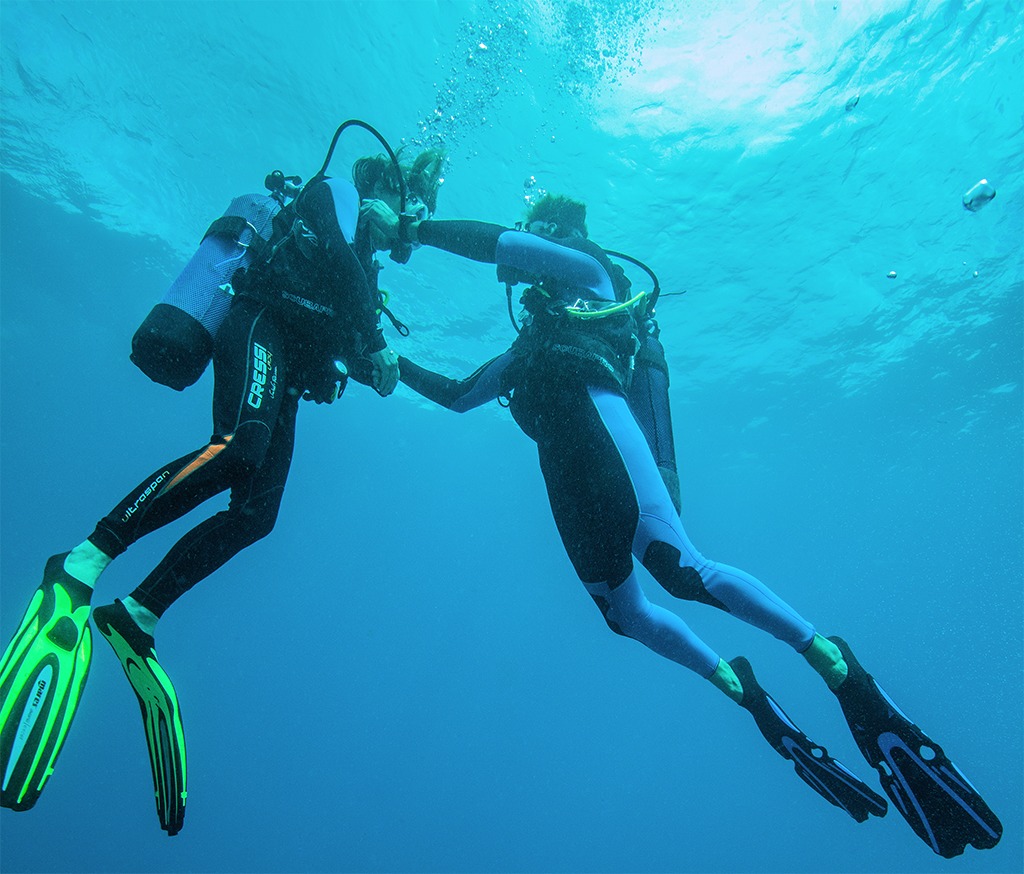
- Remontée rapide (et protocole de désaturation)
- Présentation
- Définitions
- Problématique
- Enquête réalisée par Plongée Plaisir entre le 3 et le 8 mars 2019
- Pourquoi serait-il possible de proposer une procédure ?
- Demi-profondeur, une procédure empirique répandue qui ne fait pas partie intégrante des tables MN90
- La demi-profondeur ne fait pas partie du modèle MN90 et n'est donc pas spécifique à son mode d'emploi
- Une situation ambigüe, le bon-sens et la sécurité doivent prévaloir sur toute approche dogmatique
- En conclusion
Présentation
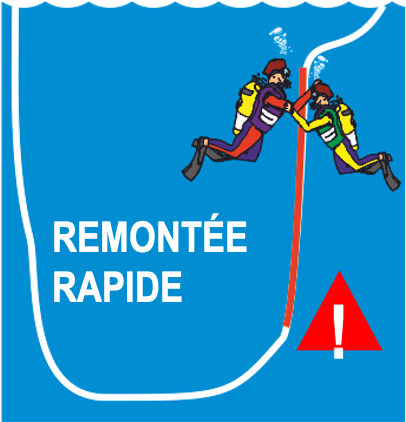
Une remontée rapide est un facteur augmentant les risques d’accidents de désaturation (ADD) par la production de bulles qu’elle provoque.
Une remontée rapide est dangereuse par nature. Elle l’est d’autant plus que l’état de saturation des plongeurs est important (temps et profondeur de plongée, plongées successives avec intervalle cours).
Aucun modèle de désaturation (et donc aucun ordinateur et aucune table de plongée) n’intègre la modélisation d’une remontée rapide qui, par définition, ne peut pas être rendue sûre par un protocole de désaturation (ce serait comme attendre des médecins qu’ils rendent la cigarette ou l’alcool inoffensifs).
Les procédures de rattrapage qui peuvent être proposées (exemple réimmersion à demi-profondeur) se situent hors modèles. Pratiquées depuis des dizaines d’années, elles ont montré leur efficacité sans pour autant offrir de garantie à 100%.
Toute remontée rapide est donc dangereuse et doit être évitée.
Définitions
Définition « physiologique »
Une vitesse de remontée est dite « rapide » si elle est dangereuse physiologiquement pour le plongeur. Depuis 1990, la « bonne » vitesse de remontée retenue mondialement est de 10 m/min (en savoir plus), soit de l’ordre de 9 à 12 m/min en pratique.
En conséquence, une remontée rapide serait une remontée à une vitesse supérieure à 12 m/min.
Définition « selon le protocole de désaturation »
Si l’on considère le protocole de désaturation (ordinateurs ou tables), alors une remontée rapide est une remontée à une vitesse supérieure à la vitesse maximale autorisée par ledit protocole ou à la marge de tolérance acceptée (ex. 110 à 120 % de la vitesse maximale autorisée pendant une durée x).
Cette définition pose les problèmes suivants :
- Si la bonne vitesse pour notre corps est de l’ordre de 10 m/min (9 à 12 m/min), les protocoles acceptant des vitesses maximales plus rapides peuvent donc être à risque (ex. vitesse initiale des tables MN90 : 17 m/min* ; tables US-Navy d’avant 1993 : 18 m/min ; ordinateurs de plongée avec les modèles Genesis ou Hollis qui prévoient une remontée à la vitesse maximale de 18 m/min).
* D’abord réduite à 15 m/min, la vitesse de remontée des tables MN90 a encore été réduite récemment. - Si la bonne vitesse pour notre corps est de l’ordre de 10 m/min (9 à 12 m/min), alors les ordinateurs qui prévoient une vitesse de remontée significativement plus faible peuvent se mettre en alarme inutilement.
Ressource supplémentaire : Fiche Info Plongée Plaisir permettant de télécharger les manuels d’utilisation des ordinateurs de plongée.
Conclusion sur les définitions
On peut regretter, alors même que la vitesse de remontée de l’ordre de 10 m/min (9 à 12 m/min) fait consensus au sein de la communauté scientifique depuis plus de 30 ans (Lang & Egstrom, Biomechanics of Safe Ascents Workshop, American Academy of Underwater Sciences, 1990), que tous les ordinateurs ou tables de plongée ne l’aient pas adoptée.
Fort heureusement, les tables US-Navy (modifiées dès 1993) et bon nombre d’ordinateurs, l’ont fait. Quant aux tables Bühlmann ou Comex, c’était déjà la vitesse retenue dès leur conception.
Pour notre part, nous retiendrons donc la définition « physiologique » : la « bonne » vitesse de remontée est une vitesse s’éloignant peu de 10 m/min (9 à 12 m/min). Au-delà de 12 m/min, la remontée est trop rapide.
Problématique
Aucun modèle de désaturation, qu’il soit transcrit sous forme de tables (ex. MN90, Bühlmann, US-Navy, Comex) ou programmé dans un ordinateur de plongée (Bühlmann, US-Navy, Comex, RGBM) ne sait « gérer » une remontée rapide, c’est à dire une remontée supérieure à la vitesse prévue par le modèle.
En toute rigueur, il faudrait donc ne jamais faire de remontée rapide.
En pratique de nombreux organismes d’enseignement, en plongée de loisir comme en plongée professionnelle, sont confrontés à des phases d’apprentissage où des vitesses de remontée plus ou moins rapides peuvent avoir lieu. Que préconiser dans ce cas :
- Ne rien faire et laisser un éventuel accident survenir ? Ce serait irresponsable.
- Déclencher systématiquement une procédure d’alerte avec envoi au caisson ? Cela conduirait à des dizaines de passages en caisson par jour au plus fort de la saison. Ce serait à la fois irréaliste et probablement pervers car cela conduirait à engorger inutilement les hôpitaux.
- Penser qu’en phase d’apprentissage, personne ne fera de remontée rapide ? Ce serait utopique.
- Proposer une procédure.
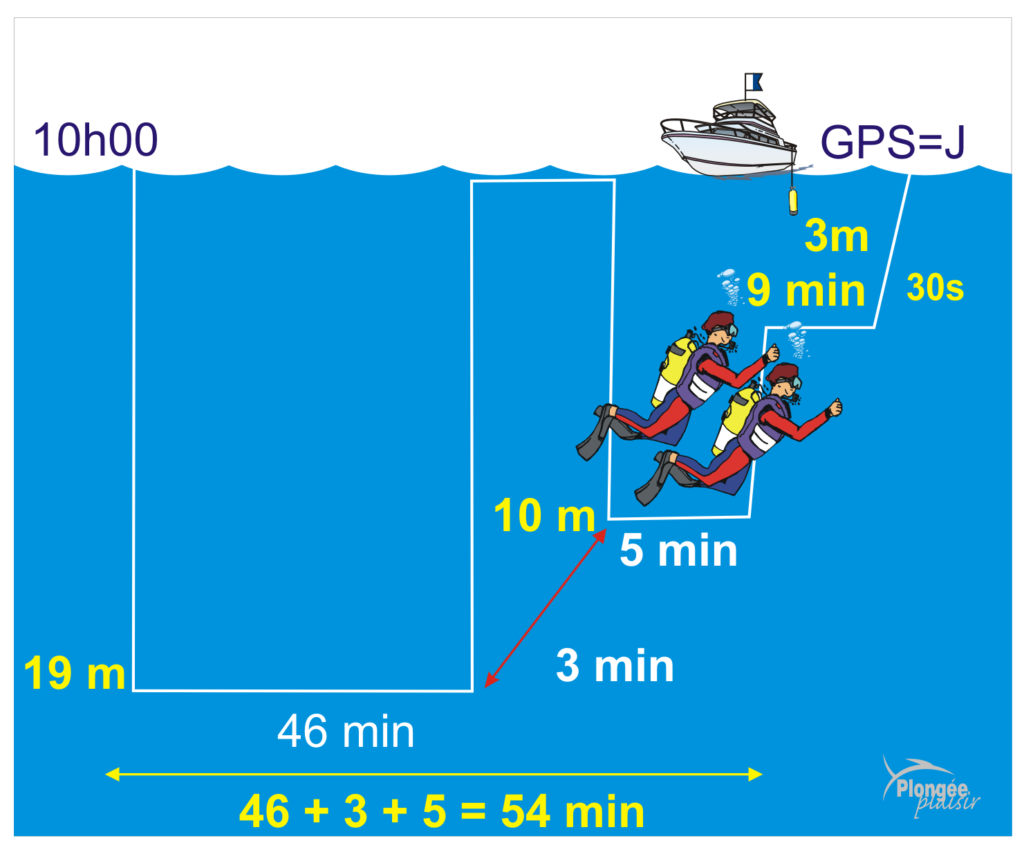
La procédure des 5 min à demi-profondeur en cas de remontée rapide n’est pas spécifique aux tables MN90.
Elle peut être utilisée avec d’autres protocoles de désaturation (tables, ordinateurs). A titre d’information, le Ministère du Travail reprend cette procédure pour les tables MT 92 (MT 2012), de même que la Fédération Suisse des Sports Subaquatiques avec les tables Bühlmann.
Enquête réalisée par Plongée Plaisir entre le 3 et le 8 mars 2019
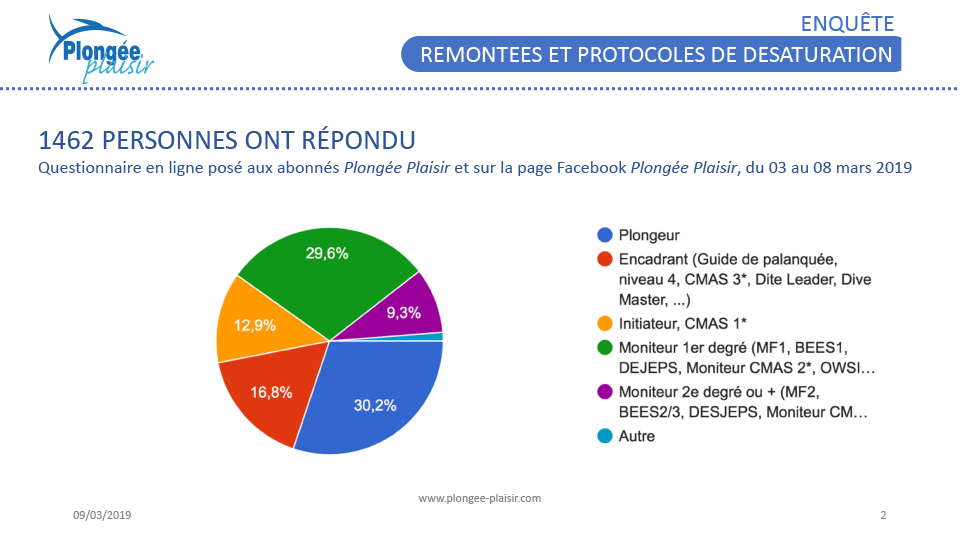
Téléchargez les résultats de l’enquête sur le sujet, posée du 3 au 8 mars 2019 auprès des membres Plongée Plaisir et des lecteurs Plongée Plaisir sur Facebook.
1462 personnes ont répondu.
Les résultats fournissent les bonnes réponses avec des explications ainsi que les statistiques de l’enquête.
Pourquoi serait-il possible de proposer une procédure ?
Comme indiqué en particulier dans Plongée Plaisir 4, un accident de désaturation (ADD) n’est pas binaire. Il s’installe puis progresse. D’où l’urgence absolue des secours, la rapidité de prise en charge permettant d’éviter des conséquences graves.
En particulier, les travaux de Michaud ont montré qu’il y avait différentes phases à partir de l’apparition de bulles potentiellement pathogènes :
- Une première phase dite « de constitution » au cours de laquelle le phénomène serait réversible. C’est le délai de rattrapage de 1*, 2 ou 3 minutes mis à profit dans certaines procédures (voir la Fiche Infos Plongée Plaisir : 3 minutes, quelle justification ?).
- Une phase d’organisation au cours de laquelle les bulles s’accumulent, grossissent, fusionnent, forment des amas et se fixent.
- Une phase de troubles.
- Une phase de séquelles éventuelles.
Demi-profondeur, une procédure empirique répandue qui ne fait pas partie intégrante des tables MN90
Le délai de latence évoqué ci-dessus a donné naissance à une procédure empirique qui trouve son origine chez les scaphandriers pieds-lourds : se réimmerger pendant 5 minutes à demi-profondeur (ou demi-pression).
Cette procédure ne fait pas partie des modèles de désaturation (aucune équation ne l’intègre) mais de leur mode d’emploi, que chaque organisme adapte alors à sa façon. Un principe est admis de tous : cette procédure ne peut être mise en oeuvre qu’en l’absence d’accident (signes, symptômes) et n’offre aucune garantie.
Ainsi :
- La Marine nationale indique dans ses Instructions pour la Plongée Autonome (IPA) que la convention retenue en cas de remontée rapide consiste à disposer de 3 minutes maximum pour se réimmerger, qu’il faut atteindre la demi-profondeur en 1 minutes maximum, y séjourner 5 minutes puis ajouter ces 9 minutes (3 + 1 + 5) au temps de plongée. Les paliers minimum sont alors de 1 minutes à 6 m et de 5 minutes à 3 m (anciennement ce minimum était de 2 minutes à 3 m). Aucune plongée ne peut avoir lieu dans les 12 heures qui suivent.
- La FFESSM indique, à propos des tables MN90 utilisées pour les examens théoriques, un délai maximum de réimmersion de 3 minutes en restant 5 minutes à demi-profondeur. Le temps entre le début de l’incident et la fin du séjour à demi-profondeur (ex. 8 min.) doit être ajouté au temps de plongée. Les paliers minimum à réaliser sont alors de 2 minutes à 3 m. A partir de quand débute le chronomètre pour comptabiliser les 3 minutes ? Cette procédure étant issue d’une démarche empirique, il n’y a pas de règle. Le tout est de convenir d’une convention … essentiellement pour faciliter le travail des examinateurs ! Dans les livres Plongée Plaisir, nous avons retenu que le délai de 3 minutes courrait du début de l’erreur (vitesse trop rapide) jusqu’à l’arrivée à demi-profondeur. Rien n’empêche ne définir une autre convention.
- Les tables MT 92 (« MT 2012 », Comex) proposent la même procédure en cas de remontée rapide (Journal Officiel de la République Française : « Travaux en milieu hyperbare »).
- Si le modèle du Pr Bühlmann ne prévoit pas le cas d’une remontée rapide, le manuel d’utilisation de la FSSS (Fédération Suisse des Sports Subaquatique) en parle et préconise la même procédure de 5 min à demi-profondeur. Brochure de la FSSS à propos des tables du Pr Bühlmann de 1986 : (pages 2 et 3).
- Après avoir fait surface, on dispose au maximum de 3 min, pour replonger : il faudra redescendre jusqu’à la moitié de la profondeur maximum atteinte et y séjourner 5 min.
- La décompression de rattrapage se calculera finalement à partir de la profondeur maximale atteinte et sur le temps total qui s’est écoulé depuis l’immersion jusqu’à cet instant (c’est à dire: temps de plongée + temps de remontée + temps passé à la surface + temps de redescente + 5 min. à demi-profondeur).
- Remerciements : Claude Millasson pour cette partie sur les tables de Bühlmann et le protocole FSSS.
La demi-profondeur ne fait pas partie du modèle MN90 et n’est donc pas spécifique à son mode d’emploi
Le document du Dr Jean-Louis Méliet qui a créé les tables MN90 n’envisage nullement les remontées rapides (tout comme Bühlmann et les autres modèles). Ce sont les IPA de la Marine nationale (ou d’autres protocoles) qui fixent comment utiliser les tables en cas de remontée rapide.
Dans le mode d’emploi original des tables MN90 (pages 42 à 45), les procédures à suivre en cas de remontée rapide ou d’interruption de paliers (les deux sont dangereuses) ne sont pas indiquées. La raison en est simple : cela ne fait pas partie de la modélisation.
Il est donc totalement infondé de prétendre que la procédure de demi-profondeur fait partie du modèle des tables MN90 et ne pourrait pas être mise en oeuvre en dehors de ce cadre. En conséquence, l’affirmation répandue sur des réseaux sociaux, selon laquelle : “Il FAUT préciser que cette procédure n’est pas compatible avec les indications de nos ordinateurs de plongée car dans ce cas il y a mélange de DEUX procédures de désaturation pour la même plongée et c’est grave ! ” est fausse.
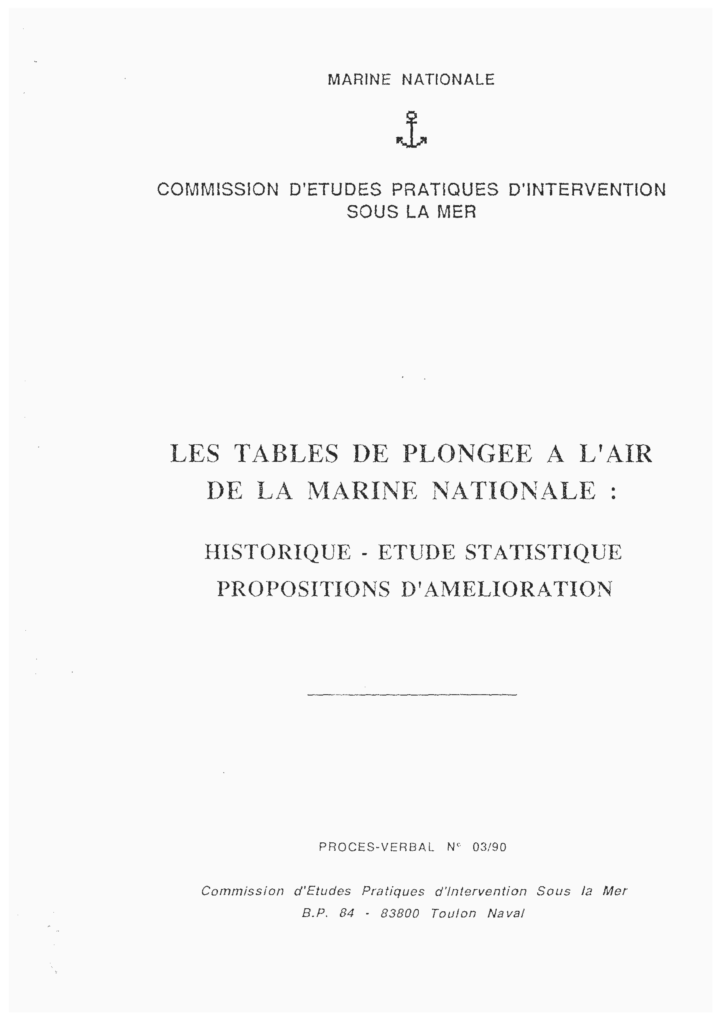
Publication originale du Dr Jean-Louis Méliet créant les tables MN90.
Comme pour tous les protocoles de désaturation, aucune procédure n’est prévue pour les remontées rapides car cela n’est pas modélisé. Il est donc faux de vouloir associer la procédure de demi-profondeur ou demi-pression (5 min) exclusivement au tables MN90. Cette procédure ne fait pas partie du modèle mais du « mode d’emploi » des organismes de plongée. La demi-profondeur en cas de remontée rapide (sans accident) est une procédure généralisée, reprise par les IPA de la Marine Nationale, le ministère du travail (tables MT92, MT 2012), la Fédération Suisse des Sports Subaquatiques (FSSS) pour les tables Bühlmann, etc. Une remontée rapide reste une procédure DANGEREUSE, non modélisée et qui ne doit jamais être faite volontairement.
Une situation ambigüe, le bon-sens et la sécurité doivent prévaloir sur toute approche dogmatique
C’est vrai pour l’ensemble des modèles de désaturation : ils sont « faits » pour une certaine vitesse de remontée. Toute vitesse plus rapide se situe « hors modèle ». La règle voudrait qu’il n’y ait JAMAIS de remontée rapide (ou d’interruption de palier), car c’est extrêmement dangereux.
Cela nous ramène aux choix déjà évoqués en début d’article :
- Ne rien faire et laisser un éventuel accident survenir ? Ce serait irresponsable.
- Déclencher systématiquement une procédure d’alerte avec envoi au caisson ? Cela conduirait à des dizaines de passage en caisson par jour au plus fort de la saison. Ce serait à la fois irréaliste et probablement pervers car cela conduirait à engorger inutilement les hôpitaux.
- Penser qu’en phase d’apprentissage, personne ne fera de remontée rapide ? Ce serait utopique.
- Proposer une procédure, faute de mieux, à la condition que les plongées aient peu saturantes (ex. début de plongée) et qu’il n’y ait aucun signe d’accident.
Dit autrement : Faute de mieux, cette procédure de réimmersion de 5 min à demi-profondeur en l’absence d’accident peut tout à fait être utilisée avec un ordinateur de plongée.
Comme préconisé dans les livres Plongée Plaisir, il est possible de cumuler, en cas de remontée rapide (début de plongée*, peu de saturation), les indications d’une table de plongée avec celles d’un ordinateur et retenir le plus restrictif des deux.
FAITES LE TEST ET VOUS VERREZ QUE DANS LA PLUPART DES CAS, LES ORDINATEURS DE DERNIÈRES GÉNÉRATIONS SERONT PLUS RESTRICTIFS QUE LES TABLES MN90-FFESSM ET FONT PARFAITEMENT LEURS CALCULS EN CAS DE RÉIMMERSION À DEMI-PROFONDEUR.
* Cas classique des plongées d’enseignement (remontée gilet, DTMR) avec exercices en début d’immersion.En conclusion
Dans tous les cas :
- Les remontées rapides ne doivent jamais être banalisées, ce qui est malheureusement souvent le cas dans l’enseignement français.
- Les remontées rapides ne doivent jamais être réalisées volontairement.
- Elles doivent être évitées autant que possible (inutile de laisser dégénérer une situation s’il n’y a aucun bénéfice pédagogiques).
- Il faut enseigner le caractère « arbitraire », et donc sans aucune garantie, de cette procédure qui reste mise en place « faute de mieux », mais qui a fait ses preuves depuis des dizaines d’années et qui est inscrite dans la réglementation française sur les travailleurs hyperbares (annexe I du 24/05/2019 sur la réglementation hyperbare (tables MT92 – Comex).
- Cette procédure n’est pas spécifique aux tables MN90-FFESSM, elle est également mise en oeuvre avec d’autres modèles.
- En cas de saturation élevée (ex. fin de plongée), un arbitrage doit avoir lieu entre la procédure de réimmersion à demi-profondeur et le déclenchement des secours. Cette procédure est avant-tout justifiée en début de plongées d’enseignement, avec une faible saturation.
- Un corps humain n’est pas une éprouvette dans un laboratoire de physique. Une recompression à demi-profondeur n’annihile pas le phénomène bullaire qui provoque, dans tous les cas, des mécanismes physiologiques de défense.
- Il est tout à fait possible d’enseigner les remontées sans jamais faire de remontée rapide, c’est une question de pédagogie mise en place (voir Plongée Plaisir Monitorats, fiche n°59 sur les techniques pédagogiques d’enseignement de la remontée gilet). Notre enseignement doit évoluer.
Alain Foret
BEES2 / DESJEPS Plongée
Auteur des livres et supports pédagogiques Plongée Plaisir
© Extrait des livres Plongée Plaisir aux Editions GAP.
Toute reproduction interdite sur quelque support que ce soit sans accord écrit de l’éditeur et de l’auteur.

